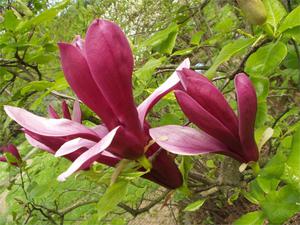
Pinyin: Xin Yi Hua Latin: Magnolia Liliflora
Physical Characteristics
A decidious Shrub growing to 3m by 4m. It is hardy to zone 6. It is in flower from April to June, and the seeds ripen from September to November. The flowers are hermaphrodite (have both male and female organs) and are pollinated by Beetles. The plant prefers light (sandy), medium (loamy) and heavy (clay) soils and requires well-drained soil. The plant prefers acid, neutral and basic (alkaline) soils. It can grow in semi-shade (light woodland) or no shade. It requires moist soil. It can tolerate atmospheric pollution.
Family
Traditional Chinese Medicinal (TCM) Uses*
Analgesic; Anodyne; Carminative; Febrifuge; Sedative; Tonic. The flowers and unopened flower buds are analgesic, anodyne, carminative, febrifuge, sedative and tonic. The main effect of this herb is to constrict blood vessels in the nasal passages and so it is taken internally in the treatment of sinusitis, allergic rhinitis and colds with a runny nose or catarrh. In excess it can cause dizziness. This herb is incompatible with Astragalus membranaceus. The flowers are harvested in the spring and can be used fresh or dried.*
Other Uses*
Hedge; Soil stabilization. Can be grown as an informal hedge, succeeding in maritime exposure. Plants have an extensive root system and can be planted to stabilize banks.*
References
Source: Magnolia Flower Magnolia Liliiflora Plants For A Future, England 1996-2008.
This work is licensed under a Creative Commons License.
Natural dietary supplements are designed to offer the body support to promote health, harmony, balance and overall well being.*

 Get Well Natural, LLC
Get Well Natural, LLC  Kidney Function & Regeneration Health
Kidney Function & Regeneration Health  Platelet & Blood Cell Health
Platelet & Blood Cell Health  Prostate, Flow & Function Health
Prostate, Flow & Function Health  General Mind & Body Health
General Mind & Body Health  Heart, Cholesterol & Cardio Health
Heart, Cholesterol & Cardio Health  Allergy-Free Body
Allergy-Free Body  Anxiety & Stress
Anxiety & Stress  Blood Platelet Counts & Function
Blood Platelet Counts & Function  Blood Pressure Health
Blood Pressure Health  Kidney Health
Kidney Health  Immune System Health & Balance
Immune System Health & Balance  Prostate & Urinary Health Function
Prostate & Urinary Health Function  Blood Sugar Balance
Blood Sugar Balance  Cardiovascular Heart Health
Cardiovascular Heart Health  Detoxification & Healthy Cells
Detoxification & Healthy Cells  Women's Health
Women's Health  Liver Regeneration
Liver Regeneration  Pain-Free Body
Pain-Free Body  Water & Air Filtration
Water & Air Filtration 


